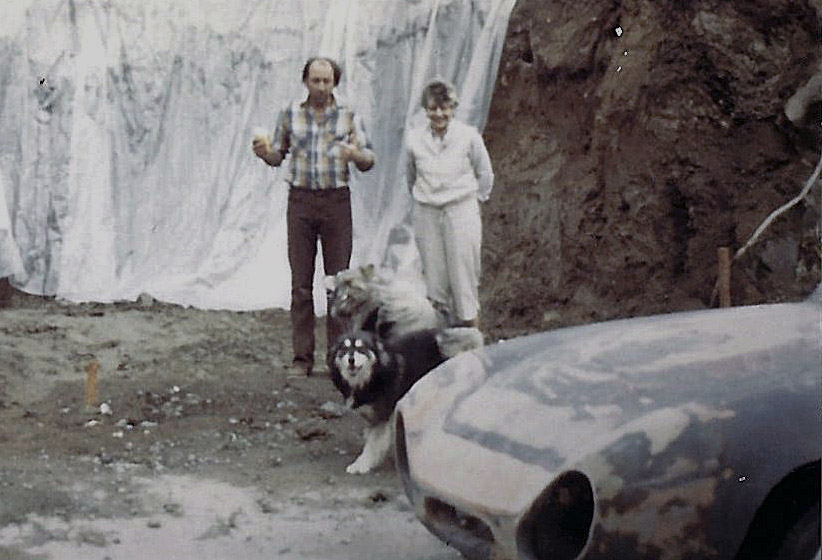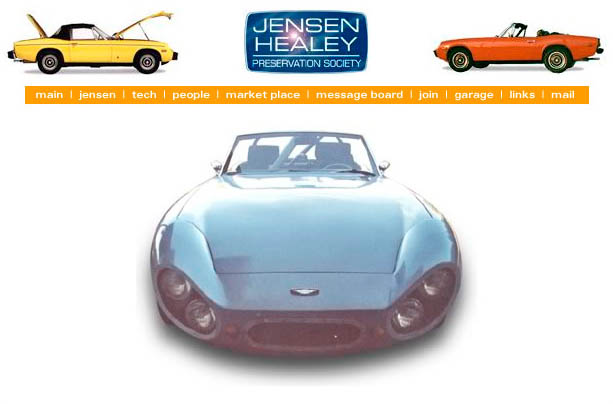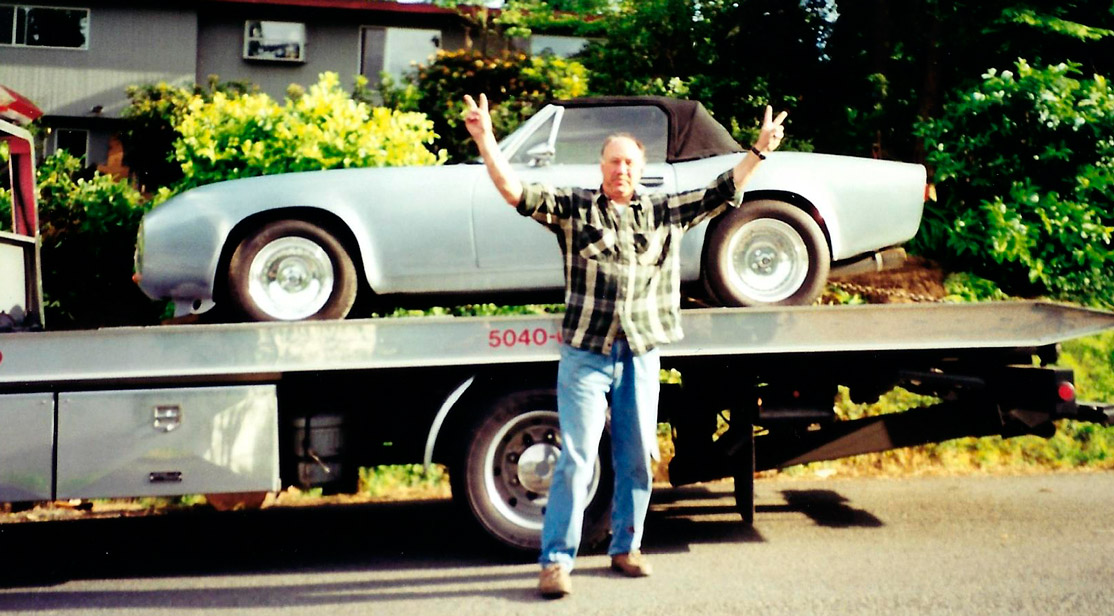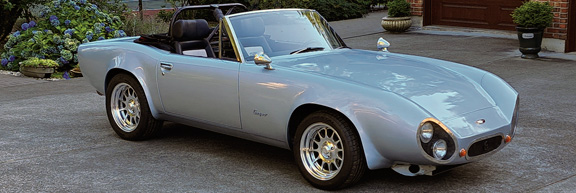 The Big Story Of How It All Happened
The Big Story Of How It All Happened
I Had No
Idea What I Was Doing
Okay, this is the convoluted story of
how I was crazy enough to spend 40 years and a ridiculous amount of money to build
what I thought was a real sports car. Far more time and probably more blood, sweat and tears than Jensen Motors, Kjell Qvale and Colin Chapman, the three principles behind the Jensen-Healey, ever spent on the project. They are all dead now
(RIP and thanks guys) so I think that means I am free to call my car whatever I want. As far as I am concerned it is a perfect sports car. I had to build it myself, for myself, but now I have the car that I had been looking for.
I call my car a Jensen-Cooper.
So, why do I think it is such a great sports car?
And why did I build it? And how did I build it?
That's what this web site is all about.
The "what", the "why", the "how".
So what exactly is the Ultimate Jensen-Cooper?
1. It is very light –
(2200lbs dry) only 2400lbs with driver and gas which is roughly 600# - 21% lighter - than a Honda S2000, 800# or 25% lighter than a Porsche Boxster S, or a BMW M Roadster – that is a lot less weight.
2. It is powerful for such a small light car - 250 bhp
& 210 ft-pds torque (with a flat torque curve) – more horsepower and a better hp/lb ratio and torque/lb ratio than the three cars above; from the Lotusbits dyno run.
3. A successful racing car; J-Hs have won five SCCA national championships and have finished a close 2nd twice.
4. Great handling - an SCCA Jensen-Healey pulled 1.112 g's on a skidpad-on 1973 wheels and tires with very few suspension modifications to the production car!
R&T SCCA Road Test here
5. My car is better and faster than the SCCA J-H because I didn't have to follow any rules. So I didn't. I had a burned out wreck that was paid for and an opportunity to start from scratch to make it just as fast and as beautiful as I wanted and it has almost all of the race-winning SCCA J-H chassis modifications too.
6. Finally, it is a convertible sports car
(an imperative) that drives and looks like it belongs with the classic sports
cars of the 60's .....in my humble opinion. Hopefully after you read this you will agree with me.
So how fast is a Jensen-Cooper? (Engine Section)
SCCA Jensen Healey vs Ferrari Daytona ('The Story' Page 3)
In the Beginning
At the time
(1983) absolutely no one built the kind of sports car that I wanted. Not one builder. Not one car. They still don't. And it drove me nuts. I knew what I wanted but I looked everywhere and I couldn't find it.
In 1984, after the engine fire, I started building
the kind of sports car I wanted but without a shop, a garage
or even a lean-to (future garage
happening in the background).

What I wanted was a car that came as close as possible to the classic definition of a real sports car. A car that you could drive around town Monday-Friday and then go race on Saturday and Sunday. I wanted a car like a Iso-Bizzarrini GT Corvette Le Mans 1965 - except that it had to be 1. a convertible 2. better looking 3. better handling 4. less weight and 5. lots of fun and easy to drive, without power steering, brakes, windows, AC, radio etc.
An article I
wrote for the Jensen Preservation
Society web site over 20
years ago "Love Story-A Work In Progress". Click
the photo to read it...

I don't know how many of you know the back-story here, but the car's builder, Giotto Bizzarrini, the man behind the 1962 Ferrari 250 GTO, really wanted to race his own car at the Le Mans 24 Hour Sports Car Race in 1965. Except he had no money. So he threw some spare parts in the boot, drove the 600 miles from his home in northern Italy to Le Mans, met up with a couple of semi-professional drivers, ran the car the entire 24 hours, finished 9th overall and first in class
(the Bizzarrini beat all the Ford GT 40s!!), and then Monday morning he drove the car 600 miles back home.
Bizzarrini didn't spend 20 million dollars to win Le Mans in 1966 like Henry Ford II did. He didn't spend a small fraction of what Enzo Ferrari spent winning Le Mans multiple times in the 50's and early 60's. He got a little money for backing from the Rivolta family and designed and built a car and went racing.
This is one of my all time favorite racing stories. There's a great book out on it, a great read. Now to me that is a real sports
car. The kind of sports car that Donald
Healey, the real father of the
Jensen-Healey and who had raced cars at
Le Mans, would have built at Jensen if he had just been given the opportunity.
The result of my first track day at
Pacific Raceways.
The Lucas alternator didn't want to spin that fast...

All I had to do was to build the kind of car that the Jensen-Healey would have, could have and should have been in the first place
(in order to race at Le Mans in 1972), except that I had no idea what I was doing – I had no experience in car building at all . I decided to just go ahead and wing it; I thought I could figure it out as I went along. At least I knew what I wanted, and that was great place to start; I just didn't know how to get from here to there.
So, the basic template for my car. A small, light street-legal, near flat-out
(occasional track day) vintage Le Mans type sports car from the late 1960's, before the government stated dictating car design and performance. High performance in the late 1960's and early 1970's would be, roughly, 0-60 in 5.5 seconds or less, 0-100 in 14 seconds or less, ¼ mile in 14 seconds or less, top speed 145-150 mph
(seriously, even on a track day how often can you drive faster than 150 mph?) and better than .9 g's on a skidpad, with braking and handling to match. Which would make it faster than a 1964 Shelby Cobra 289 with its
antiquated aerodynamics and leaf spring rear suspension or a 1968 Corvette 327-350 hp Convertible.
 Cont Page 2 Cont Page 2
 
Free Counters
|





